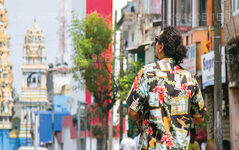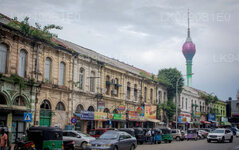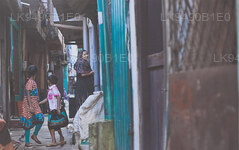
Colombo City
Colombo, the capital of Sri Lanka, is a dynamic city blending tradition and modernity. It showcases colonial architecture, lively markets, and serene Buddhist temples. With diverse cuisine, a growing skyline, and beautiful beaches, it's a vibrant hub for business, culture, and tourism, offering a gateway to explore Sri Lanka's wonders.
Slave Island (කොම්පඤ්ඤ වීදිය)
Slave Island got its name from Sri Lanka’s colonial past, when mostly African slaves were brought to the island and made to reside here. Today it’s known for its crowded settlements and colourful archaic buildings that, like the ones in Pettah, have remained over the decades.
Urban development is slowly changing the face of Slave Island though. A lot of big new commercial buildings now stand alongside ramshackle congested neighborhoods, owned by people who have lived there for generations. It’s also home to a rare part of Colombo where you get a church, kovil, mosque and temple all in one block.
Right now it’s an interesting space, where tall new structures contrast with yellowed quirky ones, and new shops live inside old buildings – it’s a mismatch of colourful walls and graffiti (watch out for stuff by street artist C215). Home now to a lot of Muslims, the blocks of homes crowded into old buildings are an interesting sight, with moss layered walls, incongruous gates, and kids skipping over the railway tracks or chilling by the Beira lake.
But like some parts of the city, we think it won’t be too long till Slave Island too gets a slick metropolitan make-over. Already, commercial buildings seem to be encroaching into what were once its residential spaces. While efficient urban spaces have their obvious appeal, it’s a little sad to think of a Slave Island without its eccentricities. Watch our video that tries to capture some of Slave Island while it lasts.
About Colombo District
Colombo is the largest city and commercial capital of Sri Lanka. It is located on the west coast of the island and adjacent to Sri Jayewardenepura Kotte, the capital city of Sri Lanka. Colombo is a busy and vibrant city with a mixture of modern life and colonial buildings and ruins and a city population of 647,100.The Colombo Metropolitan Region, defined by the districts of Colombo, Gampaha and Kalutara, has an estimated population of 5,648,000, and covers an area of 3,694.20 km²
Colombo is a multi-ethnic, multi-cultural city. It is the most populous city in Sri Lanka, with 642,163 people living within the city limits. The population of Colombo is a mix of numerous ethnic groups, mainly Sinhalese, Moors and Tamils. There are also small communities of people with Chinese, Portuguese, Dutch, Malay and Indian origins living in the city, as well as numerous European expatriates.
The great majority of Sri Lankan corporations have their head offices in Colombo. Some of the industries include chemicals, textiles, glass, cement, leather goods, furniture, and jewellery. In the city center is located South Asia's second tallest building - The World Trade Centre.
About Western Province
The Western Province is the most densely populated province of Sri Lanka. It is home to the legislative capital Sri Jayawardenepura Kotte as well to Colombo, the nation's administrative and business center. Western Province is divided into 3 main districts called Colombo (642 km²), Gampaha (1,386.6 km²) and Kalutara (1,606 km²) districts. As Sri Lanka's economic hub, all the major local and international corporations have their presence in the city and so do all the major designer and high street retailers, so be ready to indulge in some retail therapy in western province.
Having the highest population in the all the provinces, the almost all the premier educational institutions in the island are located in western province. Universities in the province include the University of Colombo, the University of Sri Jayewardenepura, University of Kelaniya, Open University, Sri Lanka, Buddhist and Pali University of Sri Lanka, General Sir John Kotelawala Defence University and University of Moratuwa .Western province has the largest amount of schools in the country, which includes National, Provincial, Private and International schools.







































